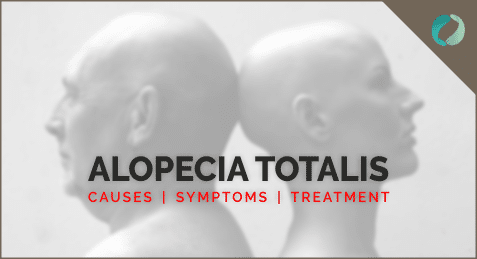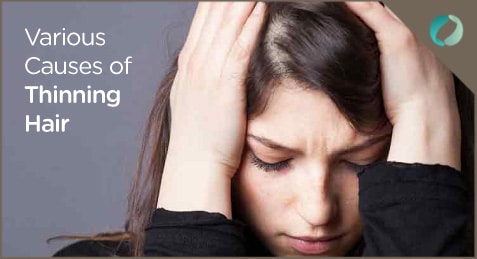Alopecia Totalis: Causes, Symptoms And Treatment
For many, ‘love is in the hair!’ So, what does one do when their lovely locks betray them for no fault of theirs? Hair loss can be traumatic for many – especially when it’s rapid and sudden. The culprit- Alopecia, is the common cause of people’s hair woes. In this article we are going to look at one form of the disease – Alopecia Totalis. What is Alopecia Totalis? Alopecia Totalis is an auto-immune disorder, which causes total hair loss, and mainly attacks the scalp. There are three conditions of hair loss- Alopecia Areata, Alopecia Totalis and Alopecia Universalis. Totalis is the intermediary condition between Alopecia Areata which causes hair loss in patches on the scalp, and Alopecia Universalis, in which there is hair loss from all over the body. Statistics have shown that about 1 in every 1,25,000 men and 1 in every 2,50,000 women suffer from Alopecia Totalis. Most of them are children and young adults (under 40 years of age), although it may affect people of all age groups. Causes of Alopecia Totalis Alopecia Totalis is the result of an auto-immune disorder that causes the immune system to attack its own hair follicles. It is a negative response by one’s immune system, where the hair follicles are seen as foreign bodies and attacked. This causes an inflammation of the hair roots, which leads to baldness. One of the main causes of Alopecia is known to be stress. When a person leads a stressful life, or is overpowered by negative emotions, hair loss in this form occurs. In most cases, the hair loss is permanent, however there have been cases of hair restoration as well. Very often, this process of hair loss and restoration becomes an ongoing pattern. Alopecia can be hereditary as well, where no amount of treatment can lead to complete and permanent hair restoration. Signs And Symptoms of Alopecia Totalis The most common sign of Alopecia Totalis is rapid hair loss from the scalp. Although it doesn’t have any physical effect on the person suffering from it, sudden hair loss has a psychological effect on them. The nature of hair loss however differs from person to person. Some of the most common symptoms of Alopecia Totalis are:
- Patchy baldness
- Receding hairline
- Thinning of hair from the scalp
Alopecia normally occurs in two forms. It might first show signs of alopecia areata, in which there is patchy hair loss followed by complete or total loss of hair on the scalp. And in other cases, there is a sudden, and complete loss of hair on the head. Of these, the second phenomenon is more common. It can also cause nails to become brittle and given them a dull, pitted appearance. Treatment For Alopecia Totalis There are various treatments available for people suffering from Alopecia Totalis. Their success in treating the condition depends on individual cases. What may work in one case may not work in another. As mentioned earlier, for some cases of Alopecia, no amount of treatment may work. Some of the most commonly resorted to treatments are:
- Medication– One of the medicines most commonly used for cure is Minoxidil, which is available even without medical prescription and can be applied by spraying onto the scalp. It is usually used in the male pattern of baldness. The other medicine which is available with prescription and is taken in the form of a pill is Finasteride.
- Steroids– Steroids have proven to be effective in treating the disease. It is initially administered in mild doses, which is later increased depending on the patient’s requirement. Steroids are given either as pills, or in the form of a gel/cream that can be applied directly on the scalp. Steroids are also at times injected into the patient’s scalp.
- Immunotherapy- In this treatment, any chemical that irritates the scalp is given to the patient. The body responds by producing anti-allergens which stimulate the hair follicles to produce new hair. Some of the side effects however are rashes, fever and low blood pressure.
- PUVA or Photochemotherapy– This treatment involves using a chemical known as psoralen along with UVA light. The chemical makes the skin sensitive to UV light and is taken normally in the form of a pill. It can also be directly applied to the hair scalp. This treatment lasts for as long as 4 to 6 months, and is resorted to when other treatments fail.
- Alternative Treatments- Ayurvedic and homeopathic treatments are said to be useful in some cases while treating Alopecia Totalis. Hypnosis, or hypnotherapy also works for some people. However, due diligence is essential before taking such treatments. It is better to do these without stopping other primary treatments.
- Cosmetics- Wigs and other hair pieces are also ways of coping with the problem of complete hair loss. They play a huge role in helping patients who do not respond to other treatments. Thanks to the latest technologies and methods in wigs and hair replacement today have a natural look that do not stand out. Hair transplant surgeries are also an option, but they are not effective in the long run particularly for Alopecia Totalis patients.
Thus, there are various treatments available for Alopecia Totalis, however, the recovery rate varies from person to person. At best, one can be positive and try the best possible treatment for hair restoration.





